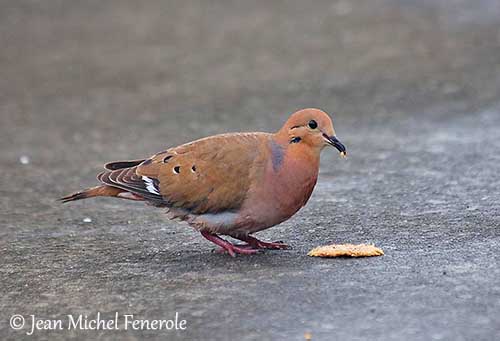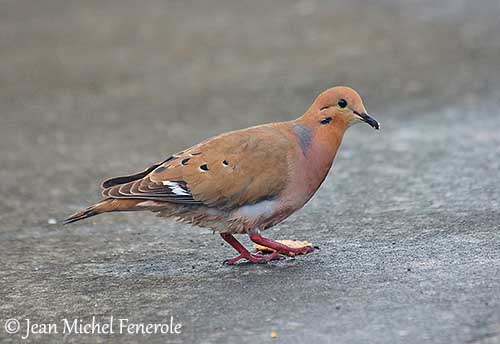
Fr : Tourterelle à queue carrée
Ang : Zenaida Dove
All : Liebestaube
Esp : Zenaida Caribeña - Tórtola Cardosantera (Puerrto Rico)
Ita : Tortora Zenaida
Nd : Antilliaanse Treurduif
Sd : Zenaidaduva
Photographers:
Jean Michel Fenerole
Photos d’Oiseaux du monde
Jean-Claude Jamoulle
A la rencontre des Oiseaux
Text by Nicole Bouglouan
Sources:
HANDBOOK OF THE BIRDS OF THE WORLD vol 4 by Josep del Hoyo-Andrew Elliott-Jordi Sargatal - Lynx Edicions - ISBN: 8487334229
PIGEONS AND DOVES by David Gibbs, Eustace Barnes and John Cox - Pica Press Sussex - ISBN: 1873403607
BirdLife International (BirdLife International)
What Bird-The ultimate Bird Guide (Mitchell Waite)
Wikipedia, the free encyclopaedia
All About Birds (Cornell Lab of Ornithology)
Zenaida Dove
Zenaida aurita
Columbiformes Order – Columbidae family
INTRODUCTION:
The genus Zenaida is included in the subfamily Columbinae in the family Columbidae. There are seven medium-sized species in the genus Zenaida, living in fairly open and lightly wooded habitats.
The Zenaida Dove has only 12 tail feathers instead of 14 in other species, except the Galapagos Dove which shares this peculiar morphological feature.
DESCRIPTION OF THE BIRD:
Biometrics:
Length: 28-30 cm
Wingspan: 36-41 cm
Weight: M: 110-194 g – F: 95-180 g
The adult of nominate race has reddish-brown back, scapulars, secondaries and median portion of rump. Breast and underparts are paler buff-brown. Alula, distal wing-coverts, primary coverts and rump sides are grey. The flight feathers are blackish-brown with secondaries and outer primaries edged white. We can see large, rounded black spots with white edge on secondaries and greater wing-coverts. The underwing is grey. The tail shows slightly graduated outer rectrices, tipped white with blackish subterminal bars and grey bases, whereas the central rectrices are reddish-brown.
The head, forehead and neck sides are cinnamon. The chin is paler and buffer. The crown is darker. Nape and hindneck are brownish-grey. The lower part of the hindneck shows metallic purple-mauve gloss extending to the neck sides. Two narrow black stripes are visible on the rear of the eye and on the ear-coverts.
The bill is black. The eyes are dark brown. Legs and feet are red.

The female resembles male but she is paler overall with less reddish back.
The juvenile lacks the iridescent neck patches, and back and wings have buff edged feathers.
SUBSPECIES AND RANGE:
The Zenaida Dove has three recognized subspecies.
Z.a. aurita (described and displayed) is found in the Lesser Antilles, from Anguilla to Grenada.
Z.a. zenaida (displayed) is found in the Bahamas, Cuba and Isle of Pines, Caiman Islands and Jamaica, Hispaniola and Puerto Rico to Virgin Islands.
This race is darker than nominate with bluish-grey rather than white terminal band on outer rectrices. The wing spots lack the white edges.
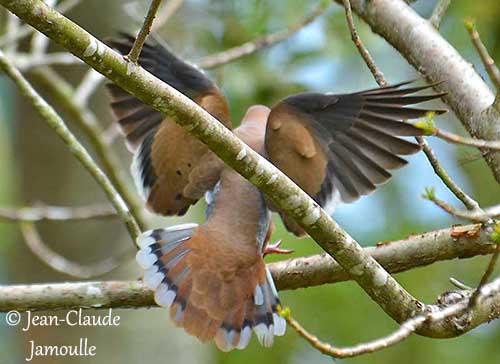
Z.a. salvadorii (not displayed) occurs on the coast of N Yucatan Peninsula and Holbox, Cozumel and Mujeres Islands.
This race is mostly greyish or olive-brown on back. The forehead is slightly washed red and the crown is greyish-mauve. The outer rectrices are tipped greyish-white.
HABITAT:
The Zenaida Dove is mainly terrestrial but it roost and nests in shrubs. It frequent shrubby grasslands, scrubland, open woodland and secondary growth, clearings and forest edges or cultivated areas and mangroves.
This species can be seen from sea-level and lowland areas up to 1500 metres of elevation in Jamaica where it frequents cultivated fields.
CALLS AND SONGS: SOUNDS BY XENO-CANTO
The Zenaida Dove utters a low, monotonous call fairly similar to that of the Mourning Dove, but delivered at more rhythmic cadence “hoo-a… ooo… ooo… ooo”
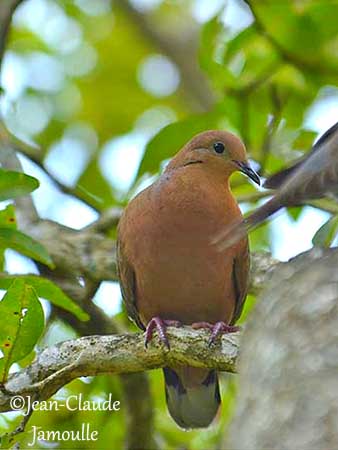
BEHAVIOUR IN THE WILD:
The Zenaida Dove forages by walking about on the ground in cultivated and urban areas or on woodland floor. It feeds mainly on grains and seeds, and may sometimes take insects (ants and flies) and earthworms. Some fruits are consumed too. In addition to its diet, it also swallows fine gravels to assist with digestion, and also takes salt from mineral rich soils. Salt may help in egg formation and pigeon-milk production.
The Zenaida Dove is often found singly or in pairs, but they often form flocks around abundant food sources after the breeding season.
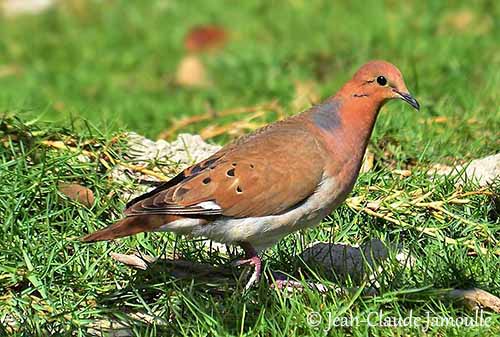
This species is monogamous at least for the season. Increase of displays announces the beginning of the breeding season. The displays are typical of Columbidae, with movements of head, wings and body. The Zenaida Dove moves the head up and down in a spasmodic manner as a prelude of displays. The male adopts a static, oblique posture with inflated crop while uttering the “perch-coo” from a perch.
Aerial displays are performed too, with exaggerated slow, deep wingbeats, followed by several loud wing-claps prior to the gliding phase. Glides and clapping are repeated several times. Then, the male descends to a perch with the wings in V shape and rocking from side to side. Copulation usually follows the displays.
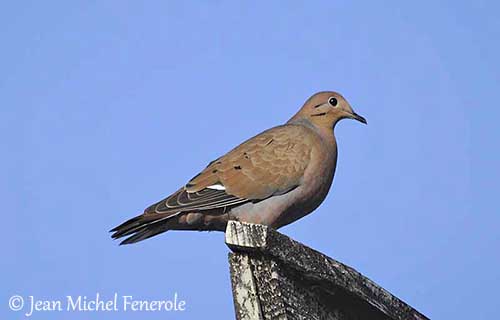
The Zenaida Dove is usually sedentary and not known making daily or seasonal movements.
This species performs fast, low, direct flight with rapid wingbeats.
REPRODUCTION OF THIS SPECIES:
The breeding season varies according to the range. They breed throughout the year in Puerto Rico, with peak between February and May, although in the south-west part of the island, the peaks are mostly March/June and October/January.
The nest is a very flimsy platform made with twigs and sometimes lined with rootlets or grasses. It is placed on the ground on the predator-free islands, on boulders and rock crevices or in grassy vegetation. But it can be built in dense, low shrub or vine-tangle too, usually up to 5 metres above the ground.
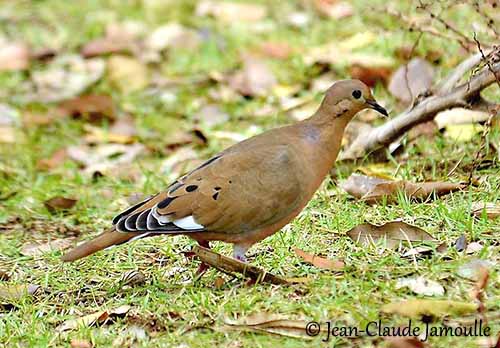
The female lays 1-2 creamy-white eggs. The incubation lasts 13-15 days, and the young fledge about two weeks after hatching. The adults nest again as soon as the juveniles are independent. This species can produce four broods per season.
PROTECTION / THREATS / STATUS:
The Zenaida Dove is not currently threatened and the population is suspected to be increasing in the West Indies. The birds benefit from habitat degradation creating new areas of suitable habitat.
However, the species suffers intense hunting pressure as this bird is a popular gamebird.
But currently, the Zenaida Dove is evaluated as Least Concern.
